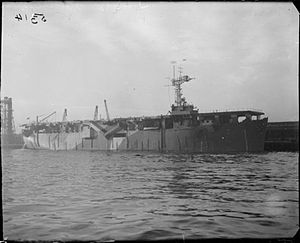HMS Vindex (D15)

HMS Vindex
|
|
| History | |
|---|---|
|
|
|
| Name: | Vindex |
| Builder: | Swan Hunter |
| Laid down: | 1 July 1942 |
| Launched: | 4 May 1943 |
| Commissioned: | 3 December 1943 |
| Honours and awards: |
|
| Fate: | Sold into merchant service as Port Vindex and scrapped at Kaohsiung August 1971 |
| General characteristics | |
| Class and type: | Nairana-class escort carrier |
| Displacement: | 13,455 long tons (13,671 t) |
| Length: | 524 ft (160 m) |
| Beam: | 68 ft 6 in (20.88 m) |
| Draught: | 21 ft (6.4 m) |
| Installed power: | 11,000 hp (8,200 kW) |
| Propulsion: |
|
| Speed: | 17 kn (20 mph; 31 km/h) |
| Complement: | 700 |
| Armament: |
|
| Aircraft carried: | 15-20 |
HMS Vindex (D15) was a Nairana-class escort carrier of the Royal Navy that saw service during the Second World War. She was built at Swan Hunter shipyards in Newcastle upon Tyne. When construction started in 1942 she was intended as a merchant ship, but was completed and launched as an escort carrier, entering service at the end of 1943.
Vindex operated escorting convoys and doing anti-submarine work in the Atlantic and Arctic theatres. Her Swordfish aircraft were involved in the sinking of four U-boats during her service. She survived the war, and immediately afterwards served in the Far East transporting men and material to and from Japan. In 1947, she was decommissioned and sold for commercial use, to Port Line and renamed Port Vindex. In 1971, she was scrapped in Taiwan.
The Nairana-class escort carriers were a class of three escort carriers built for the Royal Navy during the Second World War. Escort carriers were designed to protect convoys of merchant ships from U-boat and aircraft attack. Following the successful conversion and operation of HMS Activity, the Admiralty decided to take over three more merchant ships while they were still under construction and convert them into escort carriers. The three ships chosen were being built at three different shipyards Harland and Wolff in Northern Ireland, Swan Hunter in England and John Brown & Company in Scotland. The prototype was built by John Brown who supplied the other two companies with copies of the plans. The three ships were supposed to be identical but in reality they were all slightly different.
...
Wikipedia
